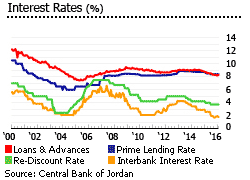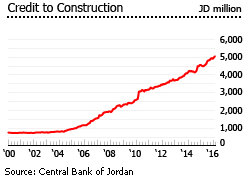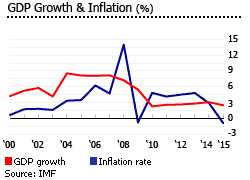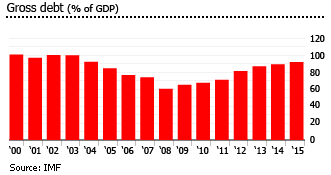How much longer will the disfunctional Greater Amman Municipality straightjacket Jordan's housing market?
Excessive bureaucracy and irrational regulations keep Amman under-housed - and the poor, the middle class, and the refugees suffer. As a band-aid solution, new incentives put in place in July 2015 have boosted the market, despite lack of broader reform. Real estate prices rose 3.3% in 2015, according to the Central Bank.
- Apartment prices were up 2%
- Villa prices increased by 1.6%
- House prices declined by 0.1%
- Land prices rose by 4.6%
More important, transactions rose significantly in the later part 2015. In December, 10,398 transactions were recorded, up 13% compared to December 2014. In the first quarter of 2016, 32,278 transactions were registered, up 45.1% compared to the same period in 2015, according to the Department of Land and Survey (DLS). A total of 2,769 building licenses were issued in January 2016, up 23.8% compared to the same month in 2015, according to DLS. Of which, 80.9% were for the construction of residential buildings - approximately 744,000 sq.m. of licensed residential building space, up 8.7%.
The July 2015 incentives mean:
- No registration fees for the first 150 square metres (sq.m.) of apartments up to 180 sq.m;
- Registration fees and tax levied on properties of all sizes, halved to 5%.
- Non-Jordanian investors exempted from fines related to delayed investments.
Around 23,585 transactions for the purchase of land (6,041 of which were transacted in the capital, Amman) took place in Q1 2016, and 8,693 for residential buildings (5,767 of which were transacted in the capital). These transactions amounted to JD1.6 billion, up 0.3% compared to Q1 2015. Around 66% of residential building transactions and 26% of land transactions in Q1 2016 were registered in Amman.
The concentration in the capital is not at all surprising given the city’s huge share of the country’s population and economic activity. Around 42% of the country’s population of 9.5 million people reside in Amman.
| Population | % of Total | |
| Ajloun | 176,080 | 2% |
| Amman | 4,000,000 | 42% |
| Aqaba | 188,160 | 2% |
| Balqa | 491,709 | 5% |
| Irbid | 1,364,000 | 14% |
| Jerash | 237,059 | 2% |
| Karak | 316,629 | 3% |
| Maan | 144,083 | 2% |
| Madaba | 189,192 | 2% |
| Mafraq | 549,948 | 6% |
| Tafileh | 96,291 | 1% |
| Zarqa | 1,364,000 | 14% |
| TOTAL | 9,500,000 | 96% |
| Source: Census Data | ||
But new housing developments in the capital are being squeezed by high land prices, according to Jordanian Housing Developers Association (JHDA) president Kamal Awamleh. Furthermore, the Greater Amman Municipality (GAM), which oversees private and public construction, is rife with red tape.

“The real estate sector witnessed a slowdown due to GAM’s measures,” said Awamleh. He pointed out that GAM imposes strict restrictions and procedures significantly limiting investments in the capital. These included time-consuming paperwork and long delays in connecting new buildings to utilities, such as water, electricity and sewage. In Jordan, a housing project must undergo 17 different official procedures all in all – while in the Arab region’s most bureaucratic countries, the average reaches only up to 9.
Housing investor Mohammad Amin agrees, saying the sector suffers from “over-complicated bureaucratic” procedures, especially in issuing occupancy permits. “We are usually out of liquidity once a complex is built, and we need quick procedures to pay banks, workers and contractors,” he said.
Apart from drawn-out procedures, GAM also restricts the number of flats in each building. “Developers want to construct buildings with 15 smaller apartments but GAM forces them to build only ten,” says Awamleh. This has resulted in larger and less affordable apartments that are basically inaccessible to the majority of Jordanians.
Of the 8,693 dwellings sold in Q1 2016:
- 2,255 measured more than 150 sq.m.
- 3,311 measured 120-150 sq.m.
- 3,127 measured less than 120 sq.m.
Furthermore, GAM also imposes height restrictions on construction, capping residential buildings at four stories and, in some areas, at two floors plus a roof above street level. Amin contends that restrictions should be abolished as unit size specifications should be subject to supply and demand.
In 2014-2015, total licensed apartments did not exceed 25,000 while the actual need was estimated at 43,000 apartments. Today, the gap may be much larger as “estimates put the market’s current need for apartments at around 60,000 units, taking into consideration that Jordan needs some 5,000 apartments every month,” according to Nidal Daoud, JHDA council member.

Red tape has become so problematic that the JHDA recently called on investors to suspend buying real estate and freeze their transactions with GAM for a month. This should prove the sector’s major impact on the municipality and the national economy, according to Awamleh.
He warned that housing developers could relocate to other countries, including the United Arab Emirates, Turkey, Egypt and Morocco due to simpler procedures and stable investment laws. In fact, more than 150 housing companies have left the market in 2015, according to JHDA council member Daoud.
GAM, on the other hand, asserts that any delays are due to disputes or failures to meet the official standards. Procedures should only take 12 days maximum if the building license transaction meets terms and conditions. Normally, around 80-85% of transactions are approved.
Jordan’s property market is expected to recover further with a steady rise in prices. Interest rates have been declining and loans to the construction industry have been on a steady rise.
Jordan´s economy grew 2.4% in 2015 and is projected to grow by 3.2% in 2016 and by 3.7% in 2017, according to the IMF. Inflation declined 0.9% in 2015, and is expected it to remain low at 0.2% in 2016.
Refugee population impacting local property market
The conflict in neighboring Syria has meant an influx of as many as 1.5 million Syrian refugees since 2011. This is compounded by large Palestinian and Iraqi refugee populations present even before the Syrian civil war. Mafraq Governorate, for example, had 154,655 refugees registered in its territory – equivalent to around half of its population as of the last census. The Zaatari refugee camp has evolved into the governorate’s largest city.
When registered refugees are added to the number of Syrian nationals residing in Jordan, the proportion could be as high as 21% of the population, according to Deputy Prime Minister Nasser Judeh,
According to a November 2013 report by REACH Resource Centre, prices of rented accommodation jumped 200-300% versus pre-crisis levels in some areas.
As of June 2014, an additional 86,000 housing units were needed to meet immediate demand, compared to 32,000 units under more normal circumstances, according to REACH.
A total of 954 transactions by Non-Jordanians took place from January to March 2016. Topping the list were Iraqis, with 39% of total foreign purchases.
Jordan in dire need of affordable housing
Refugees and native Jordanians cite housing as their area of greatest concern, as well as their largest monthly expenditure. All efforts are therefore concentrated on providing housing for Jordanians and refugees alike, and helping low-income households access affordable housing.
Royal efforts have failed in the past. In 2005, King Abdallah II kicked off the “Decent Housing for a Decent Life” campaign, which aimed to provide 120,000 affordable homes for low-income Jordanians over five years. The campaign was later abandoned, as most dwellings ended up built in rural areas, far from job opportunities.
Attracting more private investment in affordable housing may thus require broader incentive schemes and loosening of restrictions on housing construction.
Presently, the Housing and Urban Development Corporation (HUDC), a government body responsible for the kingdom’s general housing policy, in cooperation with UNHCR and several NGOs focus on four forms of intervention: cash-for-rent grants, construction of new units, winterization and upgrading of existing homes, and housing and property rights legal education.
The UNHCR and the International Catholic Migration Commission and Caritas are the primary distributors of cash for rent aid. While shelter upgrading is central to the plans of the Norwegian Refugee Council, the Jordan Health Aid Society, Medair, the Lutheran World Federation and Première Urgence-Aid Médicale Internationale (PU-AMI).
Rental yields are good
According to Global Property Guide’s latest research, gross rental yields in the capital are good at 7.0%-10.65%. Smaller-sized apartments have higher yields than larger counterparts.
The most expensive areas in the beginning of 2015, according to real estate broker Lamudi, were Abdoun, Jabal Amman, Dabouk and the areas around the capital’s Third, Fourth and Fifth Circles. Rents were around JD120 ($170) per sq metre in Abdoun, falling to about JD40 ($56) in Khalda. East Amman is generally much cheaper than West Amman, with properties of 70-80 sq metres renting for JD15,000-20,000 ($21,210-28,140) in Jabal Alakhdar, Jabal Almareekh and Jabal Al Natheef.
Regional traumas impinging on growth

The chaos in Syria and Iraq continues to hurt Jordan’s exports, tourism, and overall economic performance. GDP growth was 2.4% in 2015, below the IMF’s earlier forecast of 2.9%.
The World Bank (WB) warns that a deterioration in regional stability would undercut continued growth. Lower remittances, exports and foreign direct investments are also seen as risks, according to the WB and IMF.
“Economic growth this year is not going to be at comfortable levels. It will be below expectations,” says Finance Minister Omar Malhas.
However, WB notes that Jordan’s plan to secure an Extended Fund Facility (EFF) with the IMF could support further fiscal consolidation efforts to back “growth-enhancing and job-creating structural reforms.”

With the EFF, the IMF will deposit USD 700 million to USD 800 million in the Central Bank of Jordan, on condition that Jordan reduces public debt as a percent of GDP from 93% currently to 80% by 2021.
The IMF expects Jordan’s economy to expand by 3.2% in 2016 and 3.7% in 2017 – both lower than government projections.
Inflation in 2015 was -0.9%, owing to a decline in food and fuel-related prices. The IMF expects it to remain low at 0.2% in 2016.